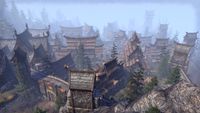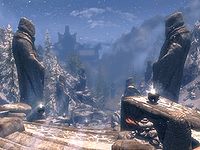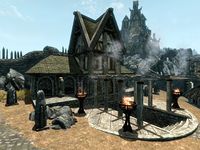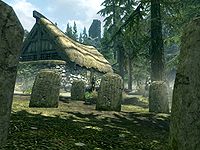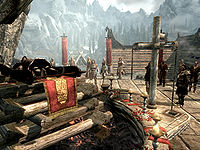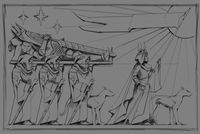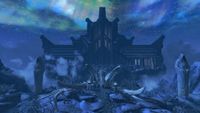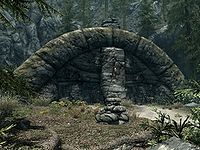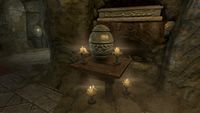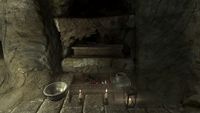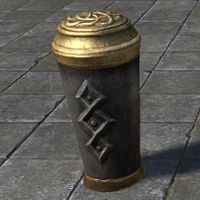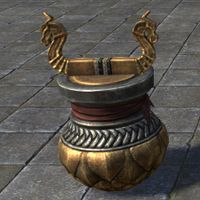Lore:Death/Nord
Nord Beliefs and Customs[edit]
Cultural Beliefs and Traditions[edit]
Falkreath is known by the epithet, the heroes' graveyard as many notable figures, from renowned warriors and noble Jarls were buried here. The town grew around the many graves and monuments that were erected on the site. Though its reputation faded over time, its people are constantly reminded and in turn celebrate, this inevitable state of life. The many shops and families find inspiration in the city's graveyard.[1][2]
Certain tall tales from the Drajkmyr marsh in Hjaalmarch claim that the deathbell flower grows in places where unfortunate deaths take place.[3]
Though broadly viewed as the same,[4][5] the Imperial deity Akatosh and the Nordic deity Alduin are not the same gods, at least according to the Nords. Alduin is known in Nordic myth as the "World Eater" and is said to devour the souls of the dead. Though most people doubt this legend because of its roots as an oral tradition,[4] it was proven true when Alduin returned to modern history in 4E 201. After his battle on the Throat of the World with the Last Dragonborn and Paarthurnax, Alduin fled to Skuldafn, one of his ancient fanes to consume souls in Sovngarde.[6]
Nord Afterlife[edit]
—A Word Wall
Nords have believed their souls will travel to Sovngarde since even before they departed Atmora.[7][8] This realm lies in the heart of Aetherius, awaiting the souls of departed warriors. Nords who prove themselves in battle awaken in the realm after death.[9] Nords are judged not by the manner in which they lived, but the manner in which they die.[10] In the end, all valiant Nords can enter Sovngarde, despite dismemberment, decapitation or evisceration.[7]
The Hall of Valor is a massive stone mead hall located in Sovngarde in which Nord heroes are welcomed to be forever honored by Shor. The hall can only be accessed by crossing the huge Whale Bone bridge which is guarded by Tsun, the shield-thane of Shor. The hall can only be entered by defeating him in a challenge or unless granted permission from Shor.[11] Pain and illness vanish within the Hall of Valor. Revelry is never-ending, mead flows freely, and the greatest Nords of all time compete in tests of strength and prowess. Even the tedium of immortality is unknown, for spectral foes wait in the surrounding shadows, waiting to do battle with those who would test their mettle.[9]
Nords' souls of those who die peacefully, executed or murdered will pass to Aetherius, in company of the other Divines, instead of traveling to Sovngarde.[12][13][14]
Shor is the Nordic version of Lorkhan. Before his doom, Shor, sometimes called the "Children's God", was chief of the gods.[5] Shor created the realm of Sovngarde before he died. After he was murdered, Shor retreated to that realm to rule over it, choosing heroes to honor according to his whims. Shor is for the Nords both the missing god of creation and the king of the dead.[9] There are many ancient Nordic legends of Shor and his compatriots. Kyne was his wife and later his widow, Stuhn was one of his Shield-thanes, and Tsun died protecting him.[5] They say he fought Alduin on the spirit plane at the beginning of time.[15] However, it is also true that Alduin feeds on the souls of the dead in Sovngarde, a privilege he guards jealously.[16]
Nord Funerary Customs[edit]
Most Nord cities have a Hall of the Dead, the way the Nords call their mausoleums, and where bodies are interred, overseen by a Priest of Orkey or Arkay, depending on the era, who ensures that corpses are properly consecrated and cared for.[17] Priests are trained to prepare and inter the corpses of the dead and to learn the proper burial rituals and prayers, sometimes, since they were children.[13][18] A Priest of Arkay in Skyrim is usually entrusted with a ceremonial dagger once they've completed their training, given by the head priest who sanctified the ritual. Ceremonial daggers and other tools were used by the Nords of old to embalm the bodies, a practice forgotten by the Fourth Era.[14][18] Besides that dagger, each priest holds an amulet of Arkay which allows them to appease the restless dead who sometimes arise from their tombs.[19] Arkay or Orkey priests in Skyrim usually live solitary lives and are seen as little more than outcasts.[18][19][13]
Smaller Nord settlements and some cities may have graveyards where their dead are buried with the same rites as those from the Hall of the Dead. Each grave is marked by a gravestone and bodies are encased in coffins.[12][20][21] Sometimes the burial has to wait for the ground to thaw, due to the harsh climate of Skyrim, but also the cold prevents the bodies from rotting quickly.[14]
Prestigious Nord clans may also have their own barrows outside of cities. These tombs are watched by their own relatives, keeping out intruders and tending to their dead.[22] This tradition dates, at least, to the very beginning of Nords' colonization of Tamriel and continued until, at least, the Second Era. Highly esteemed Nords, like honored warriors, jarls, and kings of old had their own barrow, commonly in secluded places, far from populated places.[23][24][25]
Some Nords may choose a Fire Burial, instead of interring themselves. Reasons may differ, but they are an uncommon choice, but not despised at all. This ritual involves the cremation of the body of the deceased and the consecration of the ashes by a priest, to secure their souls to depart to the afterlife.[26][12][27]
In some cases the funerary practices involved the ship burial. Olmgerd the Outlaw in Tukushapal was given that kind of burial.[28][29].
Gallery[edit]
References[edit]
- ^ Nenya's dialogue in Skyrim
- ^ Cheeses of Skyrim: Riften, Falkreath — B.
- ^ Herbalist's Guide to Skyrim — Agneta Falia
- ^ a b The Alduin/Akatosh Dichotomy — Alexandre Simon, High Priest of the Akatosh Chantry, Wayrest
- ^ a b c Varieties of Faith... — Brother Mikhael Karkuxor of the Imperial College
- ^ Odahviing's dialogue in Skyrim
- ^ a b Sovngarde, a Reexamination — Bereditte Jastal
- ^ Ysgramor's presence in Sovngarde in Skyrim
- ^ a b c The Road to Sovngarde
- ^ A Dream of Sovngarde — Skardan Free-Winter
- ^ Tsun's dialogue in Sovngarde in Skyrim
- ^ a b c Runil's dialogue in Skyrim
- ^ a b c Styrr's dialogue in Skyrim
- ^ a b c Helgird's dialogue in Skyrim
- ^ Five Songs of King Wulfharth
- ^ Events of Skyrim
- ^ Hall of the Dead loading screen in ESO
- ^ a b c Alessandra's dialogue in Skyrim
- ^ a b Andurs' dialogue in Skyrim
- ^ Kust's dialogue in Skyrim
- ^ Beneath the Stone quest in ESO
- ^ Golldir's dialogue in Skyrim
- ^ Borgas' burial in Korvanjund in Skyrim
- ^ Olaf One-Eye's burial in Dead Men's Respite in Skyrim
- ^ Ysgramor's burial in Ysgramor's Tomb in Skyrim
- ^ Glory of the Dead's quest in Skyrim
- ^ Thadgeir's dialogue in Skyrim
- ^ Ennbjof's dialogue in Morrowind
- ^ Tukushapal in Morrowind
| |||||||||||||||||||||||||

